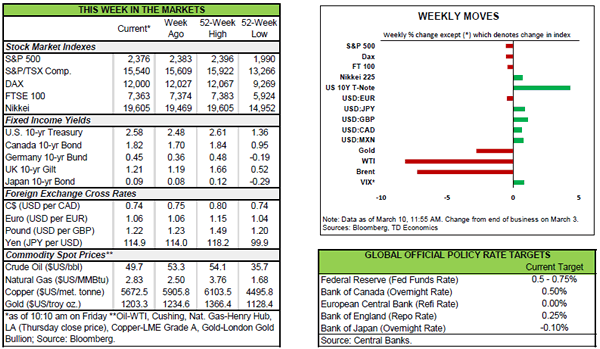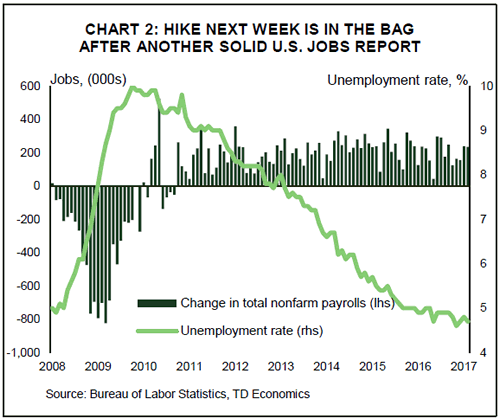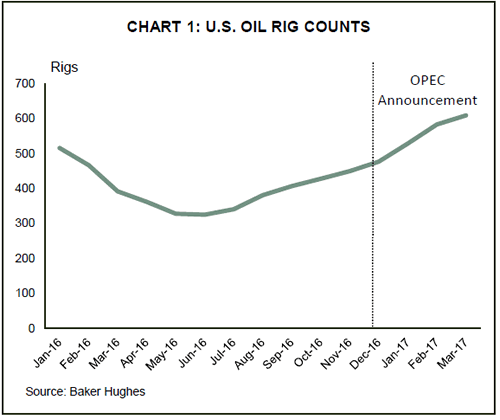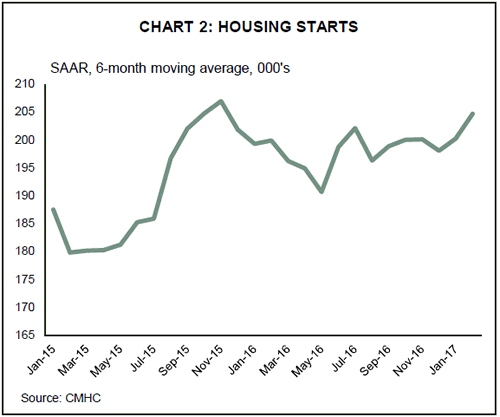HIGHLIGHTS OF THE WEEK
United States
- Markets continued to price in lofty odds for a Fed hike next week, putting further upward pressure on the 2 year treasury yield – which remained near a nine-year high. The U.S. dollar also remained relatively well supported up 0.2% on the week. Meanwhile, equity markets took somewhat of a breather, but the S&P500 only ended the week 0.5% lower.
- There were few domestic data to sift through this week, until today’s highly-anticipated jobs report. The labor market added 235k jobs on the month, with some upward revisions to the prior month. Alongside a decline in the jobless rate, these developments have further cemented the case for a rate hike next week.
- With a March hike highly-expected at this point, markets are turning attention to what is in pipeline from the Fed. Three hikes this year, alongside global central banks that remain in highly-accommodative mode should continue to support the U.S. dollar and act as a weight on economic growth. Nonetheless, we expect economic growth to remain resilient supported by continued domestic strength.
Canada
- Crude oil prices slipped below the US$50 per barrel mark this week for the first time since the end of November when OPEC countries agreed on production targets.
- Export volumes were up by a solid 1% in January, but were outpaced by a 2.5% increase in imports.
- Housing starts hit 210k units in February, bringing the 6-month moving average to 205k units – the highest level seen since November 2015.
- This morning’s employment report showed a net 15k jobs were created in February, with over 100k new full-time positions added. The unemployment rate edged down by 0.2 ppts to 6.6%.

UNITED STATES – MARCH FED HIKE ALMOST CERTAIN ON STRONG JOBS REPORT
Following last week’s relatively hawkish comments from a number of FOMC members, market participants were waiting to see if domestic data out this week would corroborate the notion that the economy is strong enough to withstand a rate hike. Markets continued to price in a hike this week, with the 2 year treasury yield continuing to face upward pressure as a result, moving up another 7bps by the end of it, at the time of writing. The more aggressive take on Fed policy has provided some support to the dollar, but the strength was offset by less-dovish rhetoric from the ECB, with the DXY just 0.2% higher at the end of the week.
Globally, the ECB’s monetary policy decision on Thursday was in focus. While Draghi hinted at a scenario where the ECB could hike rates while QE is ongoing, it is likely that the central bank will still remain on hold for quite some time. In the context of a Fed that is moving toward a faster tightening cycle when compared to the one and done pace over the last two years, dollar strength will continue to remain an ongoing theme exacerbated by this apparent divergence in monetary policy.
Meanwhile, equity markets seemed to take somewhat of a breather. The S&P 500 closed down on three of the five trading sessions, but ended the week only 0.5% lower, at the time of writing. Higher interest rates and some strength in the USD, was partly to blame, as was the slide in oil prices. Moreover, some of the sell-off was likely related to profit taking as investors cashed in after a long winning streak.
Apart for today’s employment report, there was a scarcity of first-tier domestic data this week. Tuesday’s January international trade report (Chart 1) was concerning, but the increase seen in the trade deficit to $48.5 billion was largely expected and came on the back of a strong rise in imports. It has been widely accepted that drag from net-trade will likely continue as a strengthening U.S. dollar makes imports relatively more affordable and exports more expensive. So, while disappointing given that it places a drag on overall economic growth, it only reinforced the notion that the U.S. consumer remains in good shape.
Still, while the magnitude of the positive surprise in ADP employment, which reported in the middle of the week, provided markets with a bit of a teaser, it was Friday’s payrolls report that stole the show (Chart 2). Non-farm payrolls rose by 235k in February, or well ahead of the 200k expected by the street. Upward revisions also added 9k positions and the unemployment rate ticked down by 0.1% to 4.7%. At this point these developments have cemented the case for a rate hike next week. Wage growth disappointed somewhat, but given the upside revision, accelerated nonetheless from 2.6% to 2.8% in February.
Despite the stronger dollar acting as a weight, we expect economic growth will remain resilient. Irrespective of fiscal stimulus, the economy appears to be at a point where it can handle a few hikes per year, with much of the strength hinging on the strength of the U.S. consumer. This is particularly the case if the data continues to come in robust, with wage and income gains boosting disposable incomes. Ultimately, we expect the Fed to raise rates next week, with two more hikes likely later this year should the economic outlook evolve as expected.


CANADA – MORE SIGNS OF MOMENTUM, DESPITE OIL PRICE SLIDE
Crude oil prices slipped below the US$50 per barrel mark for the first time since November 30th – the day that OPEC member countries came to an agreement on how much production they would cut. Oil took the Canadian dollar down with it – with the loonie falling briefly below 74 US cents on Thursday, but recovered most of the week’s losses on Friday following a robust jobs report.
Since the OPEC agreement, oil prices had been hovering in the low US$50 per barrel range, as markets were optimistic that these cuts, along with additional output cuts agreed upon by a group of non-OPEC countries, would help to balance the market and work down inventories. Indeed, non-commercial net long positions – a benchmark for speculative activity – have been hovering at record highs in recent weeks.
January data showed that OPEC has nearly met its target, with a high compliance rate of just over 90%. Compliance for the group of non-OPEC members was about half that. Meanwhile, U.S. production is back above 9 million barrels per day, with rig counts rising by 135 since the start of December, to just over 600. The sharp drop in prices this week was triggered by the U.S. storage report, which showed inventories rose 8.2 million barrels last week, reaching the highest level on record going back to 1982. Still rising inventories, in light of the production cuts, has reignited concerns over the supply glut currently hanging over the market.
Going forward, there certainly remains a great deal of downside risk for prices depending on how quickly (or not) markets see proof of rebalancing taking shape. Indications on whether or not OPEC will extend the quotas past June will also influence prices. Our baseline forecast is for oil prices to remain around the $50 per barrel mark in the near term, before edging up in the latter part of 2017 and in 2018 as the global market becomes more balanced.
This will help to keep the loonie fairly rangebound, lending ongoing support to Canada’s exporters. January’s trade data showed that export volumes kicked off the year on strong footing, rising 1% during the month. However, an even larger 2.5% jump in real imports means that net trade is unlikely to contribute to growth during the first quarter. On the other hand, residential construction will give growth a boost in Q1, as homebuilding activity continues to gain momentum. Housing starts hit 210k units in February, bringing the 6-month moving average to 205k units – the fastest pace seen since November 2015. This pace is unlikely to be sustained going forward, but will certainly help to underpin strong current quarter growth.
Job creation in Canada has also been gaining traction, with February’s employment report showing over 100k full time jobs added during the month. This adds further credence to the view that the Canadian economy is on track for a healthy pace of growth. That said, a considerable amount of slack remains, perhaps reflected in the recent weakness in wage growth. And, with downside risks to oil prices and a great deal of uncertainty surrounding future policy decisions stateside, the Bank of Canada is unlikely to move off the sidelines any time soon.















